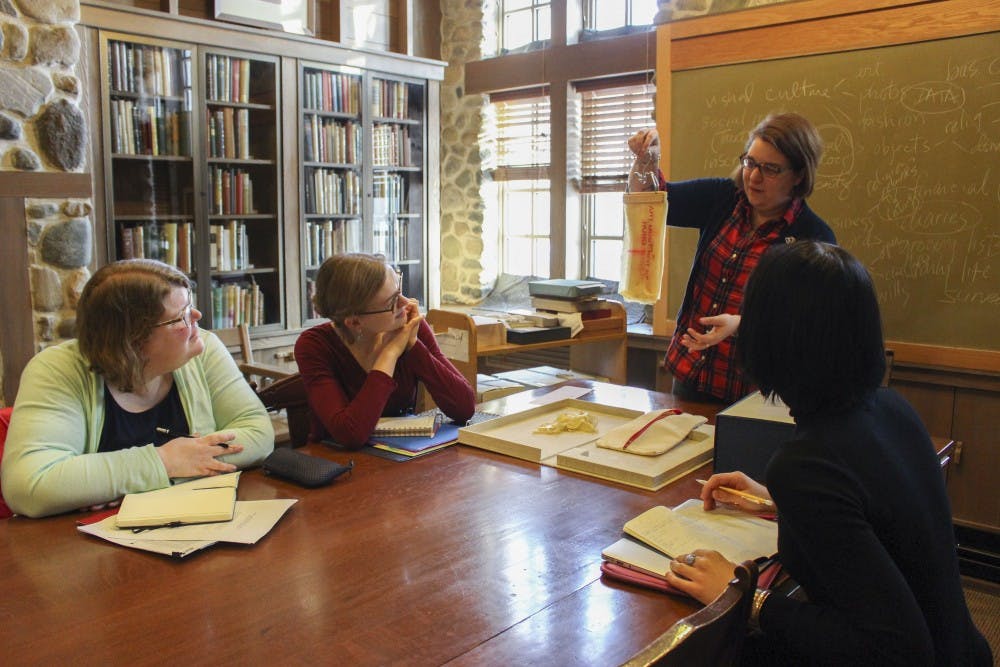Rebecca Baumann, assistant librarian at the Lilly Library, unzipped a red zipper on a white book sleeve that read “Lay text.” Inside was a garment bag with two soggy, drooping latex gloves. Baumann raised up the the book inside, a collection of six leaves of wax paper suspended on a hook.
“Art must not be hung,” the first sheet read.
This book, “Lay text” by Angela Lorenz, is in the archives of the Lilly Library on the Fine Arts Square. Other items that can be found in the library are a lock of Edgar Allan Poe’s hair, a Gutenberg Bible, mechanical puzzles on display.
Founded in 1960, the Lilly Library is the rare books, manuscripts and special collections library of IU. The collection includes 400,000 books, 100,000 pieces of music and 7.5 million manuscripts, according to the Lilly Library’s website.
“You get to show people books that are 500 years old or older,” associate director Erika Dowell said. “People are just astonished they can come into a library like this and see something like that and be allowed to touch it.”
The library also features the Jerry Slocum Puzzle Collection, with 30,000 puzzles and 4,000 puzzle-related books, according to the Lilly’s website. The mechanical puzzles in the collection are 3-D and require handheld manipulation to complete them.
“There’s such a big collection full of such interesting things, there’s something for everyone to get interested in and excited about,” Dowell said.
The library owns a book that consists of a case of multicolored pencils. Each pencil carries a line of a poem that can be arranged according to the poet’s original composition or in any way that appeals to the reader.
The pencils contain lines such as, “the lasting dream,” “nothing to do” and “which was it?”
The library owns a book titled, “Committee Report for the Arts Endowment Funding Comprehensive List of Approved Art from 1990.” The book is hardbacked with a purple cover and a giant bolt and padlock in the center of the cover.
“It’s an unreadable book,” Baumann said. “Art is locked down. This is not approved. You can’t open it.”
The book comes with a key.
“I am fairly confident the key doesn’t work,” Baumann said. “I tried it and tried it. I’m betting that’s part of the interpretation, is that you have the key, but the key doesn’t work.”
“Mars” by Daniel E. Kelm is a hexagonal artist book that comes in a set with a large ball bearing, a Civil War-era canister ball and a piece of meteorite. These represent the "three faces of Mars," according to IUCAT, Indiana University's online library catalog.
The book itself unfolds in different directions that spell out different words. One way spells out “Mars,” and other ways spell “Aries” and “God of War.” Some hexagons contain images. The book also contains pins that allow it to be built into a 3-D shape.
“This is another good example of an artist book, and an artist has all these deep thoughts and ideas about what it all means,” Baumann said.
The library also owns an unusual version of Shakespeare’s “Hamlet.”
“This is the only book in the collection that I’m not allowed to touch,” Baumann said. “I can’t open it.”
The book is printed on cork sheets, which makes a turn of a page liable to tear it.
“That’s a question of why, why would you print a book on cork?” Baumann said. “The answer is pretty much to show that you can. But, then it becomes this absolutely useless object.”
The opportunity to work with rare materials is useful for education and research, said Megan Howes, a graduate student and desk attendant.
“It helps make education and history more accessible to the public,” Howes said. “We have the first edition of 'Pride and Prejudice.' People are able to experience that firsthand.”
The library frequently presents gallery exhibits from items in its archives. Until March 2 this spring, the library's main gallery will present the exhibit "Ian Flemming: From Bibliophile to Bond."
“We have his personal papers and some of his original manuscripts for James Bond in the opening main gallery,” Howes said. “In March, we’ll have a Frankenstein exhibit.”
The Frankenstein exhibit will stay up for the rest of 2018.
Another exhibit, Welcome to 1968, runs in the Lilly Library until April 20. The exhibit displays literature, poetry, music, movies and other materials covering the political sphere of the year.
A Gutenberg Bible, one of the first books to exist in print and one of 22 bibles that still exist according to the Gutenberg Bible website, is on display in the main gallery, along with John James Audubon’s “The Birds of America,” a book of 435 large, hand-colored etchings of different birds. Each week, the Lilly Library turns the page of the book to display a new bird.
Education and outreach librarian Maureen Maryanski said she doesn't know if the other institutions that own the book necessarily have it on display all the time.
"That's a really unique thing that we have,” Maryanski said.
Along with exhibits, the Lilly participates in First Thursdays, a monthly festival with live music, food, crafts and other events on the Fine Arts Square. The library also offers classes and presentations for other classes of some of its other materials, such as the two Oscar awards in the collection.
Maryanski said she was an undergraduate when she first walked into the Lilly Library. She saw an exhibit with a first edition “A Vindication of the Rights of Women” by Mary Wollstonecraft.
“I think that book is responsible for a lot of what I do today and for me being where I am,” Maryanski said.
Maryanski said anyone with an ID is welcome to register for the reading room and look at anything the Lilly has in the collection.
“Curiosity is enough of a reason,” Maryanski said.




